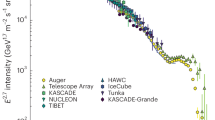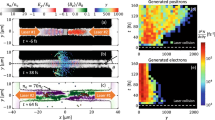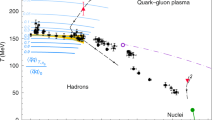Abstract
THERE are two existing models for the acceleration of positive charged particles near the magnetic polar caps of a pulsar. In the first, the work function for a 56Fe ion bound in the lattice at the stellar surface is assumed, following exhaustive calculations of Flowers et al.1, to be too large for the occurrence of ion emission. Electron–positron pairs are created through magnetic conversion of curvature photons2; the electrons are accelerated inwards to the stellar surface, and the positrons outwards along open lines of magnetic flux to the light cylinder. In the second, the work function is assumed to be negligible and ion emission limited only by space charge effects. In the corotating frame of reference, all components of the surface electric field are zero and inertial ion acceleration3–5 occurs. For surface magnetic flux densities B≳1012 G, we shall attempt to show here that the nature and mode of acceleration of the plasma moving outwards along open magnetic flux lines are determined, not by these processes, but by the occurrence of hadronic photoabsorption reactions in the electromagnetic showers produced by ultra-relativistic electrons incident on the stellar surface. This work was prompted by the comment4 that magnetic conversion of backward moving photons from these showers may be an important source of pairs. The consequences of hadronic photoabsorption do not seem to have been considered previously. Here, it is shown that photons of the energy necessary for conversion in a magnetic flux density of 1012G are emitted with high probability in hadronic photoabsorption reactions, and an equation is obtained for the acceleration potential difference in a one-dimensional model of electron–positron pair creation at the magnetic polar cap. The properties of the accelerated plasma are important owing to its probable connection with radio emission and with the phenomenon of subpulse drift occurring in certain pulsars (see, for example, refs 6, 7).
This is a preview of subscription content, access via your institution
Access options
Subscribe to this journal
Receive 51 print issues and online access
$199.00 per year
only $3.90 per issue
Buy this article
- Purchase on Springer Link
- Instant access to full article PDF
Prices may be subject to local taxes which are calculated during checkout
Similar content being viewed by others
References
Flowers, E. G. et al. Astrophys. J. 215, 291 (1977).
Ruderman, M. A. & Sutherland, P. G. Astrophys. J. 196, 51 (1975).
Michel, F. C. Astrophys. J. 192, 713 (1974).
Cheng, A. F. & Ruderman, M. A. Astrophys. J. 214, 598 (1977).
Fawley, W. M., Arons, J. & Scharlemann, E. T. Astrophys. J. 217, 227 (1977).
Ritchings, R. T. & Lyne, A. G. Nature 257, 293 (1975).
Taylor, J. H., Manchester, R. N. & Huguenin, G. R. Astrophys. J. 195, 513 (1975).
Erber, T. Rev. Mod. Phys. 38, 626 (1966).
Messel, H. & Crawford, D. F. Electron–Photon Shower Distribution Function Tables (Pergamon, Oxford, 1970).
Hayward, E. in Nuclear Structure and Electromagnetic Interaction (ed. N MacDonald) (Oliver & Boyd, Edinburgh, 1965).
Goldreich, P. & Julian, W. H. Astrophys. J. 157, 869 (1969).
Author information
Authors and Affiliations
Rights and permissions
About this article
Cite this article
JONES, P. Hadronic photoabsorption and pair production in pulsars. Nature 270, 37–38 (1977). https://doi.org/10.1038/270037a0
Received:
Accepted:
Issue Date:
DOI: https://doi.org/10.1038/270037a0
Comments
By submitting a comment you agree to abide by our Terms and Community Guidelines. If you find something abusive or that does not comply with our terms or guidelines please flag it as inappropriate.



